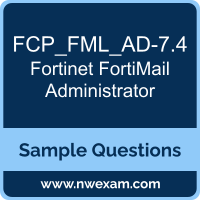01. Which FortiMail feature combats spammers who try to hide spam content in delivery status notifications (DSN) messages?
a) Bounce address tag validation (BATV)
b) Header analysis
c) Heuristic
d) Behavior analysis
02. What are two benefits of having authentication reputation tracking enabled on FortiMail?
(Choose two.)
a) Detects spoofed SMTP header addresses
b) Enforces SMTP authentication
c) Tracks offending IP addresses attempting brute force attacks
d) Temporarily locks out an attacker
03. Which two statements describe the push delivery method used by IBE?
(Choose two.)
a) Decrypted email is displayed using the HTTPS webmail interface.
b) FortiMail generates a notification email message with an embedded HTTPS URL.
c) FortiMail encrypts the email and adds it to a notification email as an HTML attachment.
d) The recipient accesses the HTTPS link and logs in to the FortiMail secure message portal.
04. What are two benefits of enabling the header manipulation feature?
(Choose two.)
a) It hides internal network information.
b) It reduces overall message size by removing header content.
c) It detects common spamming techniques.
d) It detects spoofed SMTP header addresses.
05. Which are FortiMail operating modes?
(Choose three.)
a) Transparent mode
b) Proxy mode
c) NAT/Route mode
d) Server mode
e) Gateway mode
06. When the domain keys identified mail (DKIM) feature is used, where is the public key stored?
a) The public key is stored in a DNS server as a TXT record.
b) The public key is distributed during the SMTP session establishment.
c) The public key is stored in the local FortiMail flash memory.
d) The public key is stored in a DNS server as a PTR record.
07. Which three actions does FortiSandbox perform when it is integrated with FortiMail for advanced threat protection (ATP)?
(Choose three.)
a) It analyzes file and URI objects.
b) It updates FortiGuard databases.
c) It assigns and returns a rating for analyzed objects.
d) It queues email during analysis.
e) It submits objects for sandbox scanning.
08. When deploying FortiMail in transparent mode, which of the following statements are true?
(Select all that apply)
a) FortiMail acts as an intermediary for email traffic.
b) Email attachments are automatically encrypted.
c) Transparent mode requires changes to the mail server's IP address.
d) FortiMail's functions are hidden from the email server.
e) Transparent mode is suitable for organizations with complex email infrastructures.
09. Which two types of remote authentication are supported for FortiMail administrator accounts?
(Choose two.)
a) Kerberos
b) RADIUS
c) Single Sign-on
d) TACACS
10. Which two statements about how FortiMail behaves when using transparent proxies to process email in transparent mode, are true?
(Choose two.)
a) If you disable the transparent proxies, FortiMail will use its built-in MTA to process email.
b) The outbound proxy supports DSNs, but not message queuing.
c) FortiMail ignores the destination set by the sender, and uses its own MX record lookup to deliver email.
d) The inbound proxy supports message queuing and DSNs.
 Before you write the Fortinet FortiMail Administrator (FCP_FML_AD-7.4) certification exam, you may have certain doubts in your mind regarding the pattern of the test, the types of questions asked in it, the difficulty level of the questions and time required to complete the questions. These Fortinet Certified Solution Specialist - Cloud Security (FortiMail Administrator) sample questions and demo exam help you in removing these doubts and prepare you to take the test.
Before you write the Fortinet FortiMail Administrator (FCP_FML_AD-7.4) certification exam, you may have certain doubts in your mind regarding the pattern of the test, the types of questions asked in it, the difficulty level of the questions and time required to complete the questions. These Fortinet Certified Solution Specialist - Cloud Security (FortiMail Administrator) sample questions and demo exam help you in removing these doubts and prepare you to take the test.